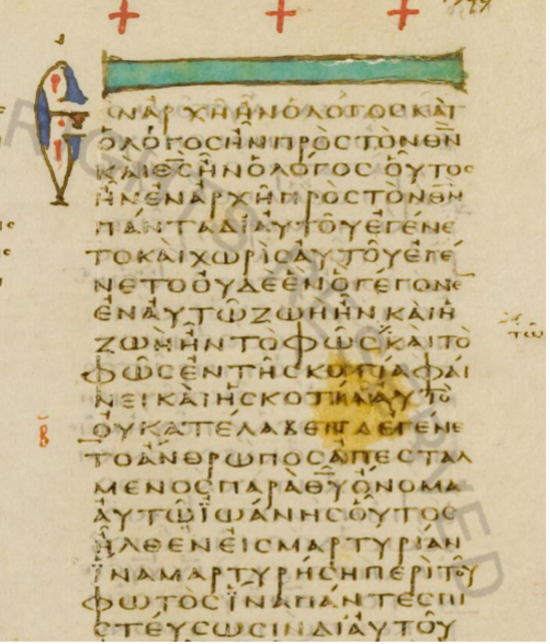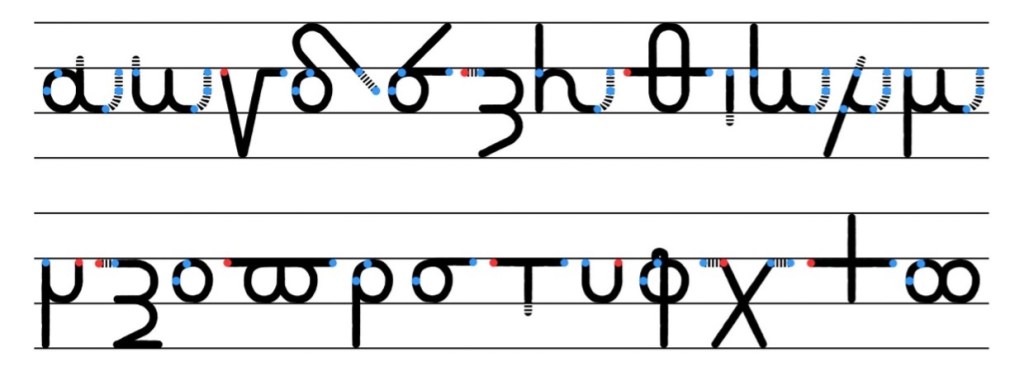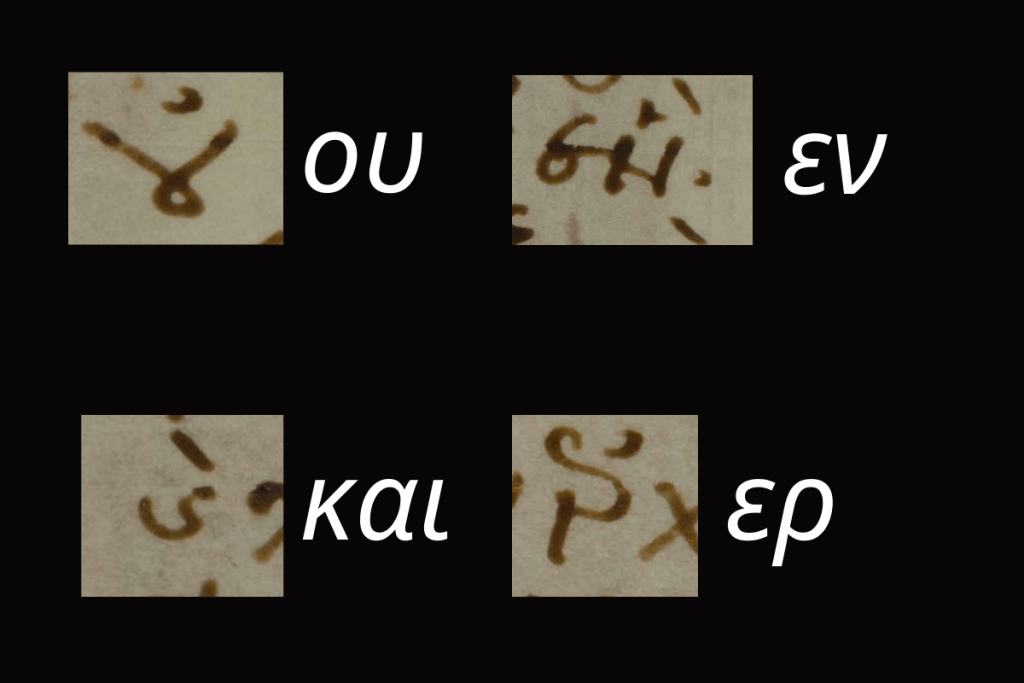By: Clark R. Bates, Guest Contributor
Before an English New Testament is produced, translators consult a critical edition of the Greek New Testament. This “critical” edition develops from the compilation and comparison of thousands of handwritten Greek manuscripts. These manuscripts range from 1700 years old to 500 years old and are produced in two, distinctly different styles of handwriting. In other words, before an English New Testament arrives at your door, the Greek New Testament is translated, but before the Greek New Testament can be created, someone must read the manuscripts, but before someone reads the manuscripts, they must be trained to read the handwriting. Therefore, behind the pages of an English Bible, lies the entire history of Greek handwriting.
Greek Majuscule
It may be surprising to know that the printed Greek found in textbooks and Greek New Testaments looks considerably different than the Greek penned by scribes more than a millennium ago. This handwritten Greek was produced in two stages and two distinctly different forms. These forms are known today as “majuscule” and “minuscule“. Majuscule Greek was written in a bilinear format, or what we might consider capital letters, with the top of each letter reaching to an imaginary, overhead ruling line and the base of the letter resting on the lower ruling line. These letters were also written in scriptio continua—meaning without spaces between words—with separate strokes and no connecting points between each letter.

Papyri written in this form of Greek exist from as early as the fourth century BCE and continue into the ninth century. This style of writing likely evolved from the carving of letters into stone. Because such a plentiful written record exists historians know about the social, economic, and literary culture of Ancient Greece. New Testament texts were also first written in this form of Greek with fragmentary papyri dating as early as the third century CE. By the fourth century, the script used in the majority of New Testament papyri was refined to form a “biblical majuscule“. This was an elegant script with careful attention paid to the sizing and placement of the letters and allowed the biblical text to be produced in a true “literary” style. This script is best seen in the great codices of the fourth and fifth centuries, like Codex Vaticanus. A literary majuscule such as this was used for books to be read or displayed, while a more rudimentary form continued to be used for administrative documents.


From the fourth century to the ninth, the majuscule script dominated the literary landscape of Greek culture. However, as the years progressed a more “cursive” form of the script began to take shape, originating in the administrative documents of the fifth and sixth centuries. This new script was advantageous in that it allowed documents to be written with greater speed but disadvantageous in that it reduced the legibility of the text. Just as the Greek majuscule script underwent centuries of refinement before it would produce the admirable literary form of Codex Vaticanus and others, this cursive majuscule began to evolve into what would eventually become the predominant literary script for the Geek speaking world up to the era of the printing press: the Greek minuscule script.
Greek Minuscule
While the majuscule was written in a bilinear mode, the minuscule adopted a quadrilinear format, placing letters along an imaginary baseline and extending them to the imaginary top line, but also creating forms that only reached a midline and some that extended below the baseline. It also brought with it the curious feature known as “ligatures”, wherein multiple letters are joined together in such a way as to blur their individual identity but save space on the page. Additionally, these letters were written with rounded edges and connecting lines and introduced spacing between words, though not as consistently as we might see in English texts. The majority of New Testament manuscripts are written in this style of Greek handwriting.


Early forms of these smaller, cursive letters are found in the administrative papyri, invading more and more of the page into the seventh century. By the eighth century, writing exercises for school children contain both majuscule and minuscule letters, but, just as was true of majuscule, this rudimentary minuscule was not fit for use in literary works—especially not sacred ones. The majuscule script, as it relates to the New Testament, had developed an almost sacral identity. It was the mode for transmitting holy writ and could not be usurped easily. In the ninth century, a monastery known as the Stoudios—led by its influential abbot Theodore—produced the first literary minuscule script, now known as the Stoudite minuscule. This script was used to write the oldest dated New Testament manuscript, Petrop. Gr. 219, or the “Uspenski Gospels,” in 835 CE.

This manuscript was a four-gospel codex written in a remarkably precise minuscule form without the aid of ruling lines on each page. The Stoudite scribes were renowned for their ability to write this form of script and housed a scriptorium so disciplined that identifying one scribe’s work from another’s is nearly impossible today. The introduction of the minuscule as a vehicle for the text of scripture opened the doors for its use throughout the culture. Though majuscule script was still employed for titles, introductory and conclusory comments, and even distinguishing biblical text from commentary, by the eleventh century the majuscule script had all but disappeared. The introduction of this new form of Greek writing brought with it the use of diacritical marking systems—used to distinguish pronunciation of words and separation of syllables—as well as punctuation for dividing sentences and clauses. Additionally, the first printed Greek New Testament adopted a later form of the minuscule script as its template, ligatures included.
Conclusion
For the New Testament textual critic, knowing how to read these two forms of writing is essential and knowing the history of their development helps resolve other questions that arise regarding manuscript features and even variant readings. And as was said before, knowing this is essential to creating the critical Greek edition upon which the English Bible many read is based. So, the next time you look at your favorite biblical passage in church or at home, you might also want to take a moment and consider the thousands of years of history that lie beneath the printed letters on the page.
Clark Bates is a PhD Candidate at the Institute for Textual Scholarship and Electronic Editing under Professor Hugh Houghton and a recipient of the Midlands4Cities Doctoral Training Scholarship. Along with multiple publications he is a co-editor of, and contributor to, That Nothing May Be Lost: The New Testament Text and its Transmission as Observed in Fragments: Papers from the Twelfth Birmingham Colloquium on the Textual Criticism of the New Testament with Andrew Patton, Emmanuele Scieri, and Jacopo Marcon. He is currently working on a critical edition and translation of the Ps. Oecumenian catena of Ephesians.


